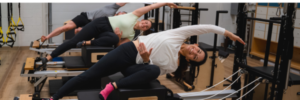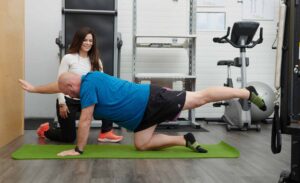Feet play an integral role in how we move through life, they provide the foundation for movement and bearing the weight of our bodies. Unfortunately, various foot problems can significantly impact how we move which ultimately affecting our overall well-being. From bunions to plantar fasciitis, these issues can cause discomfort and affect our quality of life. However, with the aid of a pedorthist, many of these common foot problems can be effectively alleviated or managed, enabling individuals to Move Well, Be Well.
Here are some common foot problems we see and how our team can help you move without pain:
1. Hallux Valgus (aka. Bunions): A common foot deformity that involves the deviation of the big toe towards the other toes. This condition typically manifests as a bony bump at the base of the big toe, causing the joint to protrude and the big toe to lean in towards the other toes.
Risk factors include:
- Genetics
- Footwear
- Foot structure
Common Symptoms include:
- Pain & tenderness
- Redness & swelling
- Limited mobility of the big toe
- overlapping toes
How can a Custom foot orthotic help alleviate the pain from hallux valgus (or Bunions)?
- Pressure Redistribution: Custom orthotics can be designed to redistribute pressure away from the bunion area, reducing the discomfort and pain experienced during walking or other weight-bearing activities. By providing cushioning and support, orthotics can help prevent additional irritation and inflammation around the bunion.
- Improved Foot Alignment: Custom foot orthotics can be tailored to address any biomechanical imbalances in the foot, ankle, or lower limbs that may contribute to the development or progression of bunions. They can help to correct irregularities in foot structure, thereby promoting better alignment and reducing the strain on the affected area.
- Reduced Friction and Irritation: Orthotics can provide a protective layer between the bunion and the shoe, helping to reduce friction and irritation. By minimizing the rubbing and pressure on the bunion, custom orthotics can prevent the development of additional complications, such as bursitis or corns, which often accompany bunions.
- Stabilization and Support: Custom orthotics can provide additional support to the arch and the affected foot, promoting better overall stability and reducing the likelihood of excessive motion that can aggravate the bunion. This enhanced stability can help in preventing further progression of the deformity and provide a more comfortable walking experience.

2. Plantar Fasciitis: Involves inflammation of the plantar fascia, a thick band of tissue that runs across the bottom of the foot, connecting the heel bone to the toes. This condition often causes stabbing pain that usually occurs with the first steps in the morning.
Risk Factors:
- Physical activity
- Age & gender
- Improper footwear
- Foot mechanics
Common Symptoms:
- Pain & tenderness
- Redness & swelling
- Severe morning pain
- Difficulty walking
How can a Custom foot orthotic help alleviate the pain from plantar fasciitis?
- Arch Support: Orthotics can provide proper arch support, which helps reduce the tension and strain on the plantar fascia. By supporting the arch, orthotics can prevent excessive stretching of the plantar fascia, which is often a key factor in the development of plantar fasciitis.
- Shock Absorption: Orthotic devices can absorb shock and reduce the impact on the heel and the plantar fascia during activities such as walking, running, or standing for extended periods. This cushioning effect helps to alleviate the stress on the inflamed tissue and can significantly reduce pain.
- Foot Alignment and Pressure Redistribution: Orthotics can help to realign the foot and redistribute pressure more evenly across the foot. By providing proper alignment, orthotics can reduce strain on the plantar fascia and the surrounding structures, promoting a more natural gait and reducing the risk of further irritation.
- Stabilization: Orthotics can stabilize the foot and ankle, providing better support and reducing excessive motion that can exacerbate plantar fasciitis. This stabilization can help to improve foot function and reduce the tension on the plantar fascia during movement.

3. Metatarsalgia: a condition characterized by pain and inflammation in the ball of the foot, specifically the area between the arch and the toes. It often results from excessive pressure or overuse of the metatarsal bones, which are the long bones in the foot that connect the toes to the midfoot. Metatarsalgia can affect one or more of the metatarsal heads and typically develops gradually over time.
Risk factors:
- Intense activity
- Ill fitting footwear
- High arches or flat feet
Common Symptoms:
- Pain & tenderness
- Burning and/or tingling sensation
- Discomfort standing
- Feeling like there is a pebble in your shoes
How can a Custom foot orthotic help alleviate the pain from metatarsalgia?
- Pressure Redistribution: Custom foot orthotics can be designed to redistribute the pressure evenly across the foot, alleviating the excess pressure on the metatarsal heads. This helps to reduce the strain on the affected area, thereby minimizing pain and inflammation.
- Shock Absorption: Orthotics can be crafted with materials that offer shock absorption, reducing the impact on the forefoot during activities such as walking or running. This feature helps to minimize the strain on the metatarsal bones, providing relief from the discomfort associated with metatarsalgia.
- Arch Support: Custom foot orthotics can be tailored to provide adequate arch support, which helps in maintaining proper foot alignment and reducing the pressure on the metatarsal heads. This support can also help in preventing overpronation or over-supination, which can contribute to the development or worsening of metatarsalgia.
- Offloading Techniques: Orthotics can incorporate specialized padding or modifications to offload specific areas of the foot, particularly the metatarsal heads. By cushioning and supporting these areas, custom foot orthotics can reduce the pressure on the inflamed or painful regions, promoting healing and reducing discomfort.

4. Leg Length Discrepancy (LLD):Leg length discrepancy (LLD) is a condition where one leg is shorter than the other. This difference can be structural, due to the actual bone length, or functional, due to factors like muscle imbalances, pelvic tilting, or foot pronation. LLD can lead to various issues, including gait abnormalities, back pain, and joint problems.
Risk factors:
- Genetics
- Injury and/or motor vehicle accident
- Fast growth spurt
Common Symptoms:
- Low back pain
- Abnormal gait
- One sided pain
How can a Custom foot orthotic help alleviate the pain from a leg length discrepancy?
- Compensation for Height Difference: Custom foot orthotics can be designed with a lift or elevation to compensate for the length difference between the legs. By providing the necessary height adjustment, orthotics help to balance the pelvis and spine, reducing the strain on the lower back, hips, and knees that often results from LLD.
- Improved Alignment: Custom foot orthotics can be crafted to support the feet and promote proper alignment, thereby helping to minimize any compensatory movements or postural imbalances that may develop due to LLD. By improving overall body alignment, orthotics can reduce the stress and strain on the muscles and joints throughout the lower body.
- Enhanced Shock Absorption: Orthotics can incorporate materials that offer enhanced shock absorption, helping to mitigate the impact of walking or running on the affected leg. This feature can reduce the discomfort and fatigue associated with LLD by providing better cushioning and support during weight-bearing activities.
- Reduced Strain on Joints: By promoting better alignment and weight distribution, custom foot orthotics can help reduce the strain on the joints, such as the hips, knees, and ankles, on the shorter leg’s side. This can contribute to improved comfort and functionality, allowing individuals with LLD to engage in daily activities with less pain and discomfort.

Foot problems can significantly impact one’s quality of life, causing discomfort and limiting mobility. However, with the expertise of pedorthists and the use of custom orthotics and appropriate footwear modifications, many of these common foot issues can be effectively managed or alleviated. If you experience any of the described foot problems above or know someone who does, book an assessment with one of our Pedorthist and let us help you Move Well, Be Well.



